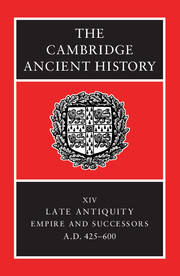Book contents
- Frontmatter
- PART I CHRONOLOGICAL OVERVIEW
- PART II GOVERNMENT AND INSTITUTIONS
- PART III EAST AND WEST: ECONOMY AND SOCIETY
- PART IV THE PROVINCES AND THE NON-ROMAN WORLD
- 18 The north-western provinces
- 19 Italy, A.D. 425–605
- 20 Vandal and Byzantine Africa
- 21a Asia Minor and Cyprus
- 21b Syria, Palestine and Mesopotamia
- 21c Egypt
- 22a The Sasanid monarchy
- 22b Armenia in the fifth and sixth century
- 22c The Arabs
- 23 The Balkans and Greece 420–602
- PART V RELIGION AND CULTURE
- Conclusion
- Chronological Table
- BIBLIOGRAPHY
- Index
- References
18 - The north-western provinces
from PART IV - THE PROVINCES AND THE NON-ROMAN WORLD
Published online by Cambridge University Press: 28 March 2008
- Frontmatter
- PART I CHRONOLOGICAL OVERVIEW
- PART II GOVERNMENT AND INSTITUTIONS
- PART III EAST AND WEST: ECONOMY AND SOCIETY
- PART IV THE PROVINCES AND THE NON-ROMAN WORLD
- 18 The north-western provinces
- 19 Italy, A.D. 425–605
- 20 Vandal and Byzantine Africa
- 21a Asia Minor and Cyprus
- 21b Syria, Palestine and Mesopotamia
- 21c Egypt
- 22a The Sasanid monarchy
- 22b Armenia in the fifth and sixth century
- 22c The Arabs
- 23 The Balkans and Greece 420–602
- PART V RELIGION AND CULTURE
- Conclusion
- Chronological Table
- BIBLIOGRAPHY
- Index
- References
Summary
The period between the accession of the Roman emperor Valentinian III in 425 and the death of the Visigothic king Leovigild in 586 inevitably occupies a central position in the debates relating to the transition from classical to medieval in western Europe, and more specifically to the questions of continuity and discontinuity. There is, however, another way of reading this century and a half, and that is as a period in its own right. Several historians working on fifth- and sixth-century Britain have, for instance, argued that between the history of the late Roman province of Britannia and that of Anglo-Saxon England lies a shorter but none the less distinct period that has been called ‘sub-Roman’.
Britain can, of course, be seen as experiencing a history radically different from that even of the other parts of western Europe. Its western half was one of only two areas of the erstwhile Roman empire to witness the re-emergence of Celtic kings, and the other area where a similar development occurred, Brittany, had a history inseparable from that of Britain itself. Meanwhile, or perhaps subsequently, Latin language and culture were more thoroughly destroyed in the Germanic kingdoms of eastern Britain than in any other part of what had been the Roman west. Yet the distinctions between Britain and the rest of western Europe may seem clearer to us now, when examined with the benefit of hindsight, than they were at the time.
- Type
- Chapter
- Information
- The Cambridge Ancient History , pp. 497 - 524Publisher: Cambridge University PressPrint publication year: 2001
References
- 2
- Cited by



